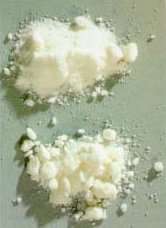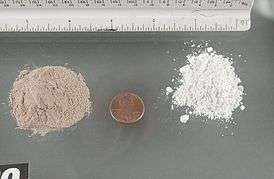Speedball (drug)
Speedball (or powerball) is a mixture of cocaine (a stimulant) with heroin or morphine (an opioid) or sometimes benzodiazepine, taken intravenously or by insufflation.[1] Speedball is a dangerous mixture, often more so than the sum of the parts due to drug synergy. The original speedball used cocaine hydrochloride mixed with morphine sulfate, as opposed to heroin.[2] Speedball may also use pharmaceutical opioids, benzodiazepines, or barbiturates along with stimulants. However, since opioids and sedative-hypnotics have different objective and subjective effects, stimulant–nonopioid mixtures are known by the slang term "set up".[3] A cocktail of drugs containing an opioid can cause a strong physical dependence and withdrawal symptoms.


Physiological response
Cocaine acts as a stimulant, whereas heroin/morphine acts as a depressant. Co-administration is meant to provide an intense rush of euphoria with a high that is supposed to combine the effects of both drugs, while hoping to reduce the negative effects, such as anxiety, hypertension, palpitations and other common side effects of stimulants and sedation/drowsiness from the depressant. While this is somewhat effective, as one drug (the CNS stimulant) triggers the sympathetic nervous system and the other (the CNS depressant) triggers the parasympathetic nervous system, the two systems that regulate the fight-or-flight and rest-and-digest responses, respectively, and simultaneous activity of the two pathways is what normally keeps one's body in natural homeostasis, there is an imperfect overlap in the effects of stimulants and depressants. Additionally, by suppressing the typical negative side-effects of the two drugs, the user may falsely believe they have a higher tolerance, or that they are less intoxicated than they actually are. This can cause users to misjudge the intake of one or both of the drugs, sometimes fatally.
Because the stimulant effects of cocaine wear off far more quickly than the depressant effects of heroin or morphine, fatal respiratory depression often occurs when the full effects of a heroin or morphine overdosage are felt in isolation. Due to the countering effect of the cocaine, a fatally high opioid dose can be unwittingly administered without immediate incapacitation, thus providing a false sense of tolerance until it is too late. This form of delayed opioid overdose is believed to be the most common mechanism of death in speedball overdoses.
Notable deaths attributed to speedball use
- Jean-Michel Basquiat,[4] though some sources list his death as heroin overdose only.[5]
- John Belushi[4]
- Ken Caminiti[6]
- Chris Farley,[4] died of cocaine and morphine sulfate overdose, similar to Belushi.[7]
- Pete Farndon[8]
- Zac Foley[9]
- Trevor Goddard[10]
- Mitch Hedberg[11]
- Philip Seymour Hoffman,[12] died of cocaine, heroin, benzodiazepines, and amphetamines overdose.[4][13][14]
- Sebastian Horsley[15]
- Chris Kelly[16]
- Brent Mydland[17]
- River Phoenix[18]
- DJ Rashad[19]
- Eric Show[20]
- Judee Sill[21]
- Layne Staley[22]
- Joey Stefano,[23] died of cocaine, morphine, heroin and ketamine overdose.
Other notable users
Other notable users of the speedball drug combination have included:
- circa 1900, Harry Kendall Thaw, a mentally ill and profligate wealthy heir who was adjudicated not guilty of murder by reason of insanity[24]
- Cream bassist Jack Bruce (as stated in an interview with the Daily Record in 2009)
- Nikki Sixx (in The Heroin Diaries: A Year in the Life of a Shattered Rock Star and The Dirt)
- Anthony Kiedis (in his autobiography Scar Tissue)
- John Frusciante[25]
- Kurt Cobain (in his biography Heavier Than Heaven)
- David Crosby (in his autobiography Long Time Gone)
- Jerry Garcia (who died of a heart attack for which his prior use of the drug may have been a contributing factor)
- Miles Davis[26]
- Ryan Adams[27]
- Slash (discussed in his autobiography Slash, he experienced cardiac arrest for eight minutes, but was revived)[28]
- Comedian Craig Ferguson (admitted in Season 9, episode 207 of The Late Late Show)[29]
- Dave Gahan of the band Depeche Mode (who suffered a heart attack following a speedball overdose, but survived)[30]
- Steven Adler (who had a stroke after taking a speedball, leaving him with a permanent speech impediment)[31]
See also
- Brompton's mixture
- Combined drug intoxication
- Drug abuse
- List of deaths from drug overdose and intoxication
- Poly drug use
References
- Martin, Peter R.; Weinberg, Bennett Alan; Bealer, Bonnie K. (2007). Healing Addiction: An Integrated Pharmacopsychosocial Approach to Treatment. Hoboken, New Jersey: Wiley-Interscience. p. 122. ISBN 978-0-47165-630-2.
- Rowlett, K.; Negus, S. S.; Shippenberg, T. S.; Mello, N. K.; Walsh, S. L. & Spealman, R. D. "Combined Cocaine and Opioid Abuse: From Neurobiology to the Clinic". Opioids.com. Retrieved 19 November 2018.
- Spears, Richard (1981). Slang and Euphemism : A Dictionary of Oaths, Curses, Insults, Sexual Slang and Metaphor, Racial Slurs, Drug Talk, Homosexual Lingo, and Related Matters. Middle Village, New York: Jonathan David. ISBN 978-0-82460-259-8.
- "Death by Drugs: Fatal Celebrity Drug and Alcohol Addictions". Gatehouse Academy. Archived from the original on 14 March 2011. Retrieved 27 March 2010.
- Davies, Carole Boyce (2008). "Basquiat, Jean-Michel (1960-1988)". Encyclopedia of the African Diaspora: Origins, Experiences, and Culture. ABC-CLIO. p. 150. ISBN 978-1-85109-700-5.
- Litsky, Frank (2 November 2004). "Report Says Overdose Killed Caminiti". The New York Times. Retrieved 19 November 2018.
- "Chris Farley's Death Laid to Drug Overdose". The New York Times. 3 January 1998. Retrieved 24 June 2010.
- Henke, James (26 April 1984). "Chrissie Hynde Without Tears". Rolling Stone.
- Peacock, Tim (1 October 2002). "Obituary: Zac Foley". Whisperin' and Hollerin'. Retrieved 5 May 2010.
- "JAG star died from drug overdose, coroner rules". The Sydney Morning Herald. 6 August 2003. Retrieved 19 November 2018.
- "Report: Mitch Hedberg died of drug overdose". Today. Associated Press. 27 December 2005. Retrieved 19 November 2018.
- "Philip Seymour Hoffman Killed By Massive OD Heroin, Coke, Rx Meds". TMZ. 28 February 2014. Retrieved 19 November 2018.
- Sanchez, Ray (28 February 2014). "Coroner: Philip Seymour Hoffman died of acute mixed drug intoxication". CNN. Retrieved 12 May 2014.
- Soltis, Andy (28 February 2014). "Hoffman Died from Toxic Drug Mixture". New York Post. Retrieved 19 November 2018.
- "UK artist Sebastian Horsley dies of overdose". NineMSN. 18 June 2010. Archived from the original on 14 July 2012. Retrieved 16 June 2010.
- Markman, Rob (2 May 2013). "Report: Kris Kross' Chris Kelly Autopsy Complete". MTV. Retrieved 3 May 2013.
- "Grateful Dead Member Died of Drug Overdose". Los Angeles Times. United Press International. 11 August 1990. Retrieved 19 November 2018.
- Mydans, Seth (13 November 1993). "Death of River Phoenix Is Linked To Use of Cocaine and Morphine". The New York Times. Retrieved 19 March 2013.
- Gordon, Jeremy (7 August 2014). "DJ Rashad Died of Drug Overdose, Autopsy Confirms". Pitchfork. Retrieved 7 August 2014.
- "Rules of abuse: MLB should include street drugs in testing". The San Diego Union-Tribune. 24 May 2008. Archived from the original on 13 March 2012. Retrieved 29 April 2010.
- Alfonso, Barry (2002). The Billboard Guide to Contemporary Christian Music. Billboard Books. p. 243. ISBN 978-0-8230-7718-2.
- "Report: Staley Died Of Heroin/Cocaine Overdose". Billboard. 8 May 2002. Retrieved 29 April 2010.
- Aldrich, Robert; Wotherspoon, Garry (23 November 2000). Who's Who in Contemporary Gay and Lesbian History Vol.2: From World War II to the Present Day. Routledge. p. 387. ISBN 978-0-203-99408-5. Based on information from Charles Isherwood's Wonder Bread and Ecstasy.
- Law, Sarah L. (2014). Pittsburgh's Point Breeze. Arcadia Publishing. p. 18. ISBN 978-1-4671-2233-7.
- "The Chili Peppers Rise Again". Rolling Stone. Retrieved on August 8, 2007
- Davis, Miles; Troupe, Quincy (1990). Miles: The Autobiography. Simon & Schuster. p. 335. ISBN 978-0-671-72582-2.
- Goodman, Lizzy (15 May 2017). "The Last Moments Of The Last Great Rock Band". Vulture.com. Retrieved 17 May 2017.
- Hudson, Saul (2007). Slash. United States: HarperEntertainment. p. 480. ISBN 978-0-06-135142-6.
- 2K13TvShow1 (31 July 2013). "The Late Late Show Craig Ferguson Courtney Love Interview July 29, 2013". YouTube. Retrieved 28 July 2015.
- Davis, Johnny (28 October 2007). "This Much I Know: Dave Gahan, singer, 45, London". The Observer. Retrieved 12 May 2016.
- Himmelsbach, Eric (8 July 2004). "Little Drummer Boy Lost". LA CityBeat. Southland Publishing.
External links
- "National Trends in Drug Abuse, Summer 1998, Special Section: Speedballing". U.S. Office of National Drug Policy. Archived from the original on 13 July 2001.